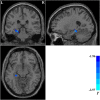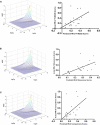Abnormal spontaneous neural activity in hippocampal-cortical system of patients with obsessive-compulsive disorder and its potential for diagnosis and prediction of early treatment response
- PMID: 35910254
- PMCID: PMC9334680
- DOI: 10.3389/fncel.2022.906534
Abnormal spontaneous neural activity in hippocampal-cortical system of patients with obsessive-compulsive disorder and its potential for diagnosis and prediction of early treatment response
Abstract
Early brain functional changes induced by pharmacotherapy in patients with obsessive-compulsive disorder (OCD) in relation to drugs per se or because of the impact of such drugs on the improvement of OCD remain unclear. Moreover, no neuroimaging biomarkers are available for diagnosis of OCD and prediction of early treatment response. We performed a longitudinal study involving 34 patients with OCD and 36 healthy controls (HCs). Patients with OCD received 5-week treatment with paroxetine (40 mg/d). Resting-state functional magnetic resonance imaging (fMRI), regional homogeneity (ReHo), support vector machine (SVM), and support vector regression (SVR) were applied to acquire and analyze the imaging data. Compared with HCs, patients with OCD had higher ReHo values in the right superior temporal gyrus and bilateral hippocampus/parahippocampus/fusiform gyrus/cerebellum at baseline. ReHo values in the left hippocampus and parahippocampus decreased significantly after treatment. The reduction rate (RR) of ReHo values was positively correlated with the RRs of the scores of Yale-Brown Obsessive-Compulsive Scale (Y-BOCS) and obsession. Abnormal ReHo values at baseline could serve as potential neuroimaging biomarkers for OCD diagnosis and prediction of early therapeutic response. This study highlighted the important role of the hippocampal-cortical system in the neuropsychological mechanism underlying OCD, pharmacological mechanism underlying OCD treatment, and the possibility of building models for diagnosis and prediction of early treatment response based on spontaneous activity in the hippocampal-cortical system.
Keywords: hippocampus; obsessive–compulsive disorder; parahippocampus; regional homogeneity; support vector machine.
Copyright © 2022 Yan, Shan, Li, Liu and Guo.
Conflict of interest statement
The authors declare that the research was conducted in the absence of any commercial or financial relationships that could be construed as a potential conflict of interest.
Figures




Similar articles
-
Regional homogeneity in patients with obsessive-compulsive disorder and depression: A resting state functional magnetic resonance imaging study.Neurosci Lett. 2023 Nov 20;817:137528. doi: 10.1016/j.neulet.2023.137528. Epub 2023 Oct 19. Neurosci Lett. 2023. PMID: 37865188
-
Localized Connectivity in Obsessive-Compulsive Disorder: An Investigation Combining Univariate and Multivariate Pattern Analyses.Front Behav Neurosci. 2019 Jun 13;13:122. doi: 10.3389/fnbeh.2019.00122. eCollection 2019. Front Behav Neurosci. 2019. PMID: 31249515 Free PMC article.
-
Comparison of resting-state spontaneous brain activity between treatment-naive schizophrenia and obsessive-compulsive disorder.BMC Psychiatry. 2021 Nov 3;21(1):544. doi: 10.1186/s12888-021-03554-y. BMC Psychiatry. 2021. PMID: 34732149 Free PMC article.
-
Alterations of regional spontaneous brain activity in obsessive-compulsive disorders: A meta-analysis.J Psychiatr Res. 2023 Sep;165:325-335. doi: 10.1016/j.jpsychires.2023.07.036. Epub 2023 Aug 2. J Psychiatr Res. 2023. PMID: 37573797 Review.
-
Abnormalities of Localized Connectivity in Obsessive-Compulsive Disorder: A Voxel-Wise Meta-Analysis.Front Hum Neurosci. 2021 Sep 16;15:739175. doi: 10.3389/fnhum.2021.739175. eCollection 2021. Front Hum Neurosci. 2021. PMID: 34602998 Free PMC article.
Cited by
-
Deviant spontaneous neural activity as a potential early-response predictor for therapeutic interventions in patients with schizophrenia.Front Neurosci. 2023 Aug 31;17:1243168. doi: 10.3389/fnins.2023.1243168. eCollection 2023. Front Neurosci. 2023. PMID: 37727324 Free PMC article.
-
Cerebral blood flow and cardiovascular risk effects on resting brain regional homogeneity.Neuroimage. 2022 Nov 15;262:119555. doi: 10.1016/j.neuroimage.2022.119555. Epub 2022 Aug 11. Neuroimage. 2022. PMID: 35963506 Free PMC article.
-
Functional and structural MRI based obsessive-compulsive disorder diagnosis using machine learning methods.BMC Psychiatry. 2023 Oct 30;23(1):792. doi: 10.1186/s12888-023-05299-2. BMC Psychiatry. 2023. PMID: 37904114 Free PMC article.
-
Decreased gray matter volume and dynamic functional alterations in medicine-free obsessive-compulsive disorder.BMC Psychiatry. 2023 Apr 25;23(1):289. doi: 10.1186/s12888-023-04740-w. BMC Psychiatry. 2023. PMID: 37098479 Free PMC article.
-
Disrupted interhemispheric coordination of sensory-motor networks and insula in major depressive disorder.Front Neurosci. 2023 Mar 7;17:1135337. doi: 10.3389/fnins.2023.1135337. eCollection 2023. Front Neurosci. 2023. PMID: 36960171 Free PMC article.
References
-
- Alemany-Navarro M., Costas J., Real E., Segalàs C., Bertolín S., Domènech L., et al. (2019). Do polygenic risk and stressful life events predict pharmacological treatment response in obsessive compulsive disorder? A gene-environment interaction approach. Transl. Psychiatry 9:70. 10.1038/s41398-019-0410-0 - DOI - PMC - PubMed
-
- American Psychiatric Association [APA] (2007). Practice Guideline for the Treatment of Patients with Obsessive–Compulsive Disorder. Arlington, VA: American Psychiatric Association. - PubMed
-
- American Psychiatric Association [APA] (2013). Diagnostic and Statistical Manual of Mental Disorders, 5th Edn. Arlington, VA: American Psychiatric Association.
LinkOut - more resources
Full Text Sources

